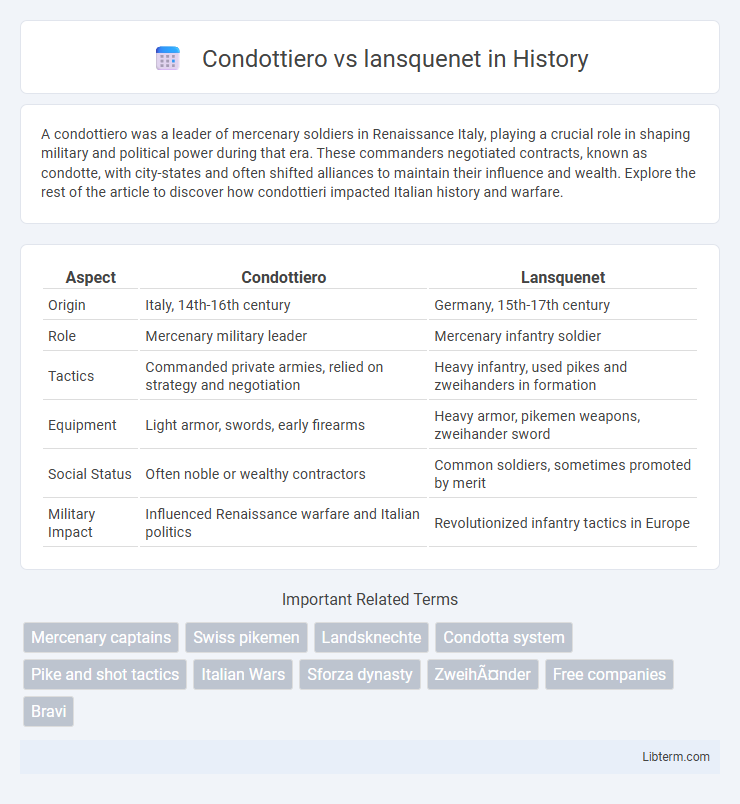A condottiero was a leader of mercenary soldiers in Renaissance Italy, playing a crucial role in shaping military and political power during that era. These commanders negotiated contracts, known as condotte, with city-states and often shifted alliances to maintain their influence and wealth. Explore the rest of the article to discover how condottieri impacted Italian history and warfare.
Table of Comparison
| Aspect | Condottiero | Lansquenet |
|---|---|---|
| Origin | Italy, 14th-16th century | Germany, 15th-17th century |
| Role | Mercenary military leader | Mercenary infantry soldier |
| Tactics | Commanded private armies, relied on strategy and negotiation | Heavy infantry, used pikes and zweihanders in formation |
| Equipment | Light armor, swords, early firearms | Heavy armor, pikemen weapons, zweihander sword |
| Social Status | Often noble or wealthy contractors | Common soldiers, sometimes promoted by merit |
| Military Impact | Influenced Renaissance warfare and Italian politics | Revolutionized infantry tactics in Europe |
Introduction to Condottieri and Landsknechts
Condottieri were Italian mercenary leaders prominent during the Renaissance, known for their strategic command and contractual military service to city-states. Lansquenets, German infantry mercenaries emerging in the 16th century, specialized in pike and firearm tactics, influencing European warfare significantly. Both groups shaped military history by introducing disciplined, professional soldiers who transformed infantry and cavalry dynamics in early modern Europe.
Historical Origins and Emergence
Condottieri originated in 14th-century Italy as mercenary military leaders who commanded private armies for city-states during the Renaissance, shaping Italian warfare with their contractual arrangements known as "condotte." Lansquenets emerged in late 15th-century Germany, formed as professional infantry mercenaries specializing in pike formations and serving prominent European powers, particularly the Holy Roman Empire. Both types of soldiers influenced the shift from feudal levies to organized, professional armies in early modern Europe.
Organizational Structure and Leadership
Condottieri were Italian mercenary leaders who operated under a hierarchical structure with centralized command, often personally leading their troops and managing contracts with city-states. Lansquenets, German mercenary infantry units, were organized into tightly disciplined companies with elected officers known as Hauptleute, emphasizing collective leadership and battlefield coordination. The contrasting leadership styles reflect the Condottieri's focus on individual authority versus the Lansquenets' structured, unit-focused command.
Weaponry and Armor Comparison
Condottieri, Italian mercenary leaders of the Renaissance, typically wielded heavy swords, lances, and crossbows, wearing polished steel plate armor designed for both mobility and protection in cavalry charges. Lansquenets, German infantry mercenaries of the 16th century, favored the zweihander greatsword and pikes, complemented by lighter armor such as burgonets and breastplates to maintain agility in pike and shot formations. The contrast in weaponry and armor reflects the Condottieri's cavalry-based tactics versus the Lansquenet's infantry-centric pike warfare.
Tactics and Battlefield Roles
Condottieri, elite mercenary commanders of Renaissance Italy, excelled in flexible, mercenary-driven tactics emphasizing fortification, negotiation, and rapid maneuvering within diverse battlefield roles including infantry and cavalry coordination. Lansquenets, German mercenary pikemen and infantry renowned from the 15th to 16th centuries, specialized in disciplined pike square formations and aggressive shock tactics to break enemy lines and hold ground, often serving as frontline spearheads. The contrast highlights Condottieri's strategic adaptability and leadership versatility versus Lansquenets' rigid, formation-based combat effectiveness.
Cultural and National Differences
Condottieri were Italian mercenary leaders prominent during the Renaissance, embodying the tactical ingenuity and political intricacies of Italian city-states, while Lansquenets were German mercenary infantry known for their discipline and distinctive armor in the 15th and 16th centuries. The Condottieri culture emphasized individual leadership and contract-based warfare within Italy's fragmented political landscape, contrasting with the Lansquenet tradition rooted in the Holy Roman Empire's emphasis on regimented infantry units and collective military action. These differences reflected broader national identities, with Italian Condottieri symbolizing Renaissance-era mercenary entrepreneurship and the Lansquenets representing the disciplined martial ethos of German mercenary forces.
Famous Battles and Encounters
Condottieri, renowned for their leadership in Italian Renaissance wars, clashed prominently with lansquenets, German mercenary infantry known for their pike and shot tactics, in battles such as the Battle of Pavia (1525), where the lansquenets played a decisive role in the Habsburg victory over the French. The Battle of Cerignola (1503) also showcased the effectiveness of lansquenets and their tactical innovations against the Spanish condottieri forces. These encounters highlighted contrasting military doctrines: the disciplined infantry squares of lansquenets versus the flexible cavalry and mixed arms approach of condottieri.
Influences on Renaissance Warfare
Condottieri and Lansquenets shaped Renaissance warfare through their distinct military tactics and organizational structures. Italian condottieri emphasized cavalry charges and contract-based leadership, influencing the development of mercenary armies in Italy during the 15th and 16th centuries. German lansquenets introduced disciplined infantry formations and the effective use of pikes and arquebuses, significantly altering battlefield strategies across Europe.
Decline and Legacy
The decline of the Condottiero system emerged in the late 16th century as centralized national armies replaced mercenary forces, while Lansquenets gradually lost prominence due to evolving military tactics and the rise of professional infantry. The legacy of Condottieri persists in the development of military strategy and Renaissance warfare, influencing European martial culture and the role of mercenaries. Lansquenets contributed significantly to early modern infantry techniques, durability, and the adaptation of pike and shot formations, shaping the future of organized military units.
Lasting Impact on Military History
Condottieri and lansquenets significantly shaped Renaissance warfare, introducing flexible infantry tactics that contrasted with traditional knightly cavalry dominance. The condottieri's use of mercenary companies influenced the development of professional armies throughout Italy, while lansquenets, known for their pike and shot formations, contributed to the evolution of combined arms strategies in Europe. Their innovations laid foundational principles for modern military organization and battlefield maneuvering.
Condottiero Infographic

 libterm.com
libterm.com